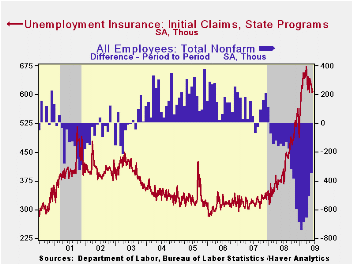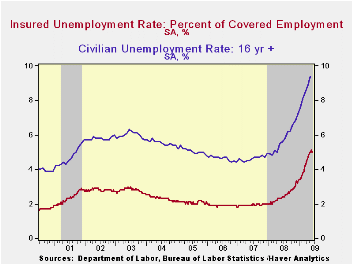 Global| Jun 18 2009
Global| Jun 18 2009U.S. Initial Jobless Insurance Claims Trend Lower But Edge Up In Latest Week
by:Tom Moeller
|in:Economy in Brief
Summary
The decline in initial claims from their high is leading evidence of labor market improvement. Though initial claims for unemployment insurance edged up last week, they remained near the lowest level since late-January. Claims inched [...]

The decline in initial claims from their high is leading evidence of labor market improvement. Though initial claims for unemployment insurance edged up last week, they remained near the lowest level since late-January. Claims inched up by 3,000 to 608,000 after a revised 20,000 decline during the prior week which was revised a bit shallower. Initial claims were down from their March peak of 674,000. In addition, the four-week average of claims, which smoothes out some of the volatility in the weekly numbers, fell to 615,750 which was its lowest level since since mid-February. Still, the level remained up by two-thirds from the year ago level. The latest level about matched the Consensus expectation which was for 605,000 claims.
The latest claims figure is for the survey week for June nonfarm payrolls. Claims fell 28,000 (4.4%) from the May survey period. During the last ten years there has been an 86% correlation between the level of claims and the change in nonfarm payrolls.
The Labor Department indicated that the largest increases in initial claims for the week ending June 6 were in Pennsylvania (+6,861), Florida (+6,469), Ohio (+5,104), California (+4,894), and New York (+4,795), while the largest decreases were in Arkansas (-1,206), Puerto Rico (-1,131), Wisconsin (-707), Arizona (-693), and Nebraska (-450).
Modest improvement in the job market finally evidenced itself in a lower level of continuing claims for unemployment insurance. They fell for the first time since early January and the decline was a large 148,000 (2.2%). Continuing claims provide an indication of workers' ability to find employment. At 6,687,000, however, claims remained more than twice the year ago level. Further suggesting that the job market's improvement is just modest was that the four-week average of continuing claims rose to another record of 6,757,500. The series dates back to 1966.
Also indicating marginal labor market improvement was that the insured unemployment rate slipped to 5.0% from 5.1%. The level remained more than double June of 2008 and the highest since 1983. During the last ten years there has been a 93% correlation between the level of the insured unemployment rate and the overall rate of unemployment published by the Bureau of Labor Statistics.
Clearly, the latest weekly figure understates labor market distress in some states.The highest insured unemployment rates in the week ending May 30 were in Michigan (7.5 percent), Oregon (7.0), Nevada (6.3), Puerto Rico (6.3), Pennsylvania (6.2), Wisconsin (6.0), Arkansas (5.6), South Carolina (5.5), California (5.4), and North Carolina (5.4).
The unemployment insurance claims data is available in Haver's WEEKLY database and the state data is in the REGIONW database.
Community Development Financial Institutions: Challenges and Opportunities is the title of yesterday's speech by Fed Chairman Ben S, Bernanke and it is available here.
| Unemployment Insurance (000s) | 06/13/09 | 06/06/09 | 05/30/09 | Y/Y | 2008 | 2007 | 2006 |
|---|---|---|---|---|---|---|---|
| Initial Claims | 608 | 605 | 625 | 55.9% | 420 | 321 | 313 |
| Continuing Claims | -- | 6,687 | 6,835 | 115.9% | 3,342 | 2,552 | 2,459 |
Tom Moeller
AuthorMore in Author Profile »Prior to joining Haver Analytics in 2000, Mr. Moeller worked as the Economist at Chancellor Capital Management from 1985 to 1999. There, he developed comprehensive economic forecasts and interpreted economic data for equity and fixed income portfolio managers. Also at Chancellor, Mr. Moeller worked as an equity analyst and was responsible for researching and rating companies in the economically sensitive automobile and housing industries for investment in Chancellor’s equity portfolio. Prior to joining Chancellor, Mr. Moeller was an Economist at Citibank from 1979 to 1984. He also analyzed pricing behavior in the metals industry for the Council on Wage and Price Stability in Washington, D.C. In 1999, Mr. Moeller received the award for most accurate forecast from the Forecasters' Club of New York. From 1990 to 1992 he was President of the New York Association for Business Economists. Mr. Moeller earned an M.B.A. in Finance from Fordham University, where he graduated in 1987. He holds a Bachelor of Arts in Economics from George Washington University.






